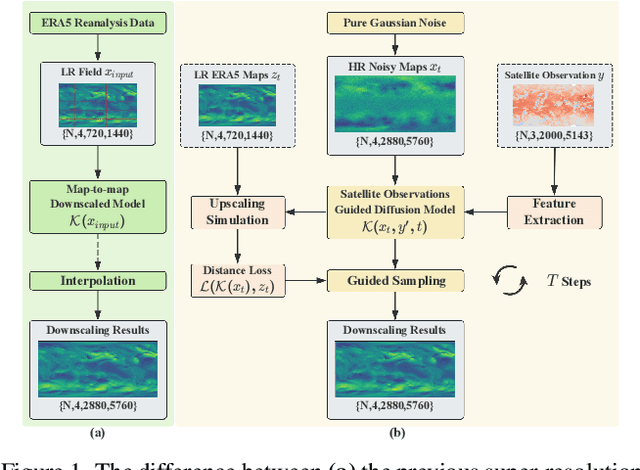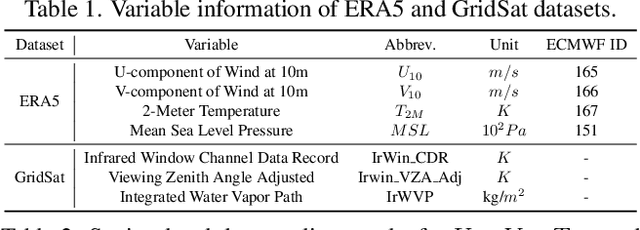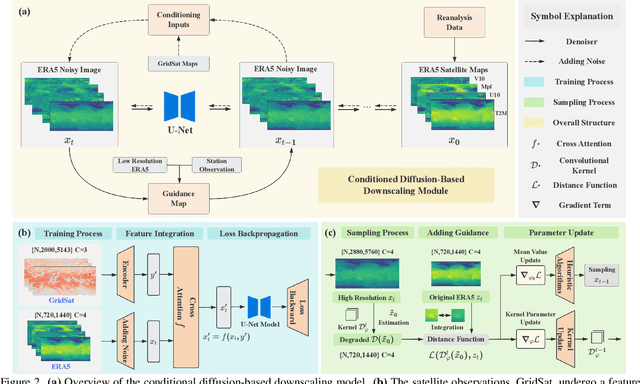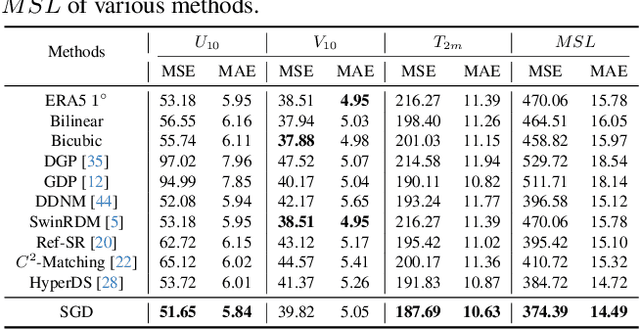Fenghua Ling
A Survey of Scientific Large Language Models: From Data Foundations to Agent Frontiers
Aug 28, 2025



Abstract:Scientific Large Language Models (Sci-LLMs) are transforming how knowledge is represented, integrated, and applied in scientific research, yet their progress is shaped by the complex nature of scientific data. This survey presents a comprehensive, data-centric synthesis that reframes the development of Sci-LLMs as a co-evolution between models and their underlying data substrate. We formulate a unified taxonomy of scientific data and a hierarchical model of scientific knowledge, emphasizing the multimodal, cross-scale, and domain-specific challenges that differentiate scientific corpora from general natural language processing datasets. We systematically review recent Sci-LLMs, from general-purpose foundations to specialized models across diverse scientific disciplines, alongside an extensive analysis of over 270 pre-/post-training datasets, showing why Sci-LLMs pose distinct demands -- heterogeneous, multi-scale, uncertainty-laden corpora that require representations preserving domain invariance and enabling cross-modal reasoning. On evaluation, we examine over 190 benchmark datasets and trace a shift from static exams toward process- and discovery-oriented assessments with advanced evaluation protocols. These data-centric analyses highlight persistent issues in scientific data development and discuss emerging solutions involving semi-automated annotation pipelines and expert validation. Finally, we outline a paradigm shift toward closed-loop systems where autonomous agents based on Sci-LLMs actively experiment, validate, and contribute to a living, evolving knowledge base. Collectively, this work provides a roadmap for building trustworthy, continually evolving artificial intelligence (AI) systems that function as a true partner in accelerating scientific discovery.
EarthLink: A Self-Evolving AI Agent for Climate Science
Jul 24, 2025


Abstract:Modern Earth science is at an inflection point. The vast, fragmented, and complex nature of Earth system data, coupled with increasingly sophisticated analytical demands, creates a significant bottleneck for rapid scientific discovery. Here we introduce EarthLink, the first AI agent designed as an interactive copilot for Earth scientists. It automates the end-to-end research workflow, from planning and code generation to multi-scenario analysis. Unlike static diagnostic tools, EarthLink can learn from user interaction, continuously refining its capabilities through a dynamic feedback loop. We validated its performance on a number of core scientific tasks of climate change, ranging from model-observation comparisons to the diagnosis of complex phenomena. In a multi-expert evaluation, EarthLink produced scientifically sound analyses and demonstrated an analytical competency that was rated as comparable to specific aspects of a human junior researcher's workflow. Additionally, its transparent, auditable workflows and natural language interface empower scientists to shift from laborious manual execution to strategic oversight and hypothesis generation. EarthLink marks a pivotal step towards an efficient, trustworthy, and collaborative paradigm for Earth system research in an era of accelerating global change. The system is accessible at our website https://earthlink.intern-ai.org.cn.
Scientists' First Exam: Probing Cognitive Abilities of MLLM via Perception, Understanding, and Reasoning
Jun 12, 2025Abstract:Scientific discoveries increasingly rely on complex multimodal reasoning based on information-intensive scientific data and domain-specific expertise. Empowered by expert-level scientific benchmarks, scientific Multimodal Large Language Models (MLLMs) hold the potential to significantly enhance this discovery process in realistic workflows. However, current scientific benchmarks mostly focus on evaluating the knowledge understanding capabilities of MLLMs, leading to an inadequate assessment of their perception and reasoning abilities. To address this gap, we present the Scientists' First Exam (SFE) benchmark, designed to evaluate the scientific cognitive capacities of MLLMs through three interconnected levels: scientific signal perception, scientific attribute understanding, scientific comparative reasoning. Specifically, SFE comprises 830 expert-verified VQA pairs across three question types, spanning 66 multimodal tasks across five high-value disciplines. Extensive experiments reveal that current state-of-the-art GPT-o3 and InternVL-3 achieve only 34.08% and 26.52% on SFE, highlighting significant room for MLLMs to improve in scientific realms. We hope the insights obtained in SFE will facilitate further developments in AI-enhanced scientific discoveries.
ReconMOST: Multi-Layer Sea Temperature Reconstruction with Observations-Guided Diffusion
Jun 12, 2025Abstract:Accurate reconstruction of ocean is essential for reflecting global climate dynamics and supporting marine meteorological research. Conventional methods face challenges due to sparse data, algorithmic complexity, and high computational costs, while increasing usage of machine learning (ML) method remains limited to reconstruction problems at the sea surface and local regions, struggling with issues like cloud occlusion. To address these limitations, this paper proposes ReconMOST, a data-driven guided diffusion model framework for multi-layer sea temperature reconstruction. Specifically, we first pre-train an unconditional diffusion model using a large collection of historical numerical simulation data, enabling the model to attain physically consistent distribution patterns of ocean temperature fields. During the generation phase, sparse yet high-accuracy in-situ observational data are utilized as guidance points for the reverse diffusion process, generating accurate reconstruction results. Importantly, in regions lacking direct observational data, the physically consistent spatial distribution patterns learned during pre-training enable implicitly guided and physically plausible reconstructions. Our method extends ML-based SST reconstruction to a global, multi-layer setting, handling over 92.5% missing data while maintaining reconstruction accuracy, spatial resolution, and superior generalization capability. We pre-train our model on CMIP6 numerical simulation data and conduct guided reconstruction experiments on CMIP6 and EN4 analysis data. The results of mean squared error (MSE) values achieve 0.049 on guidance, 0.680 on reconstruction, and 0.633 on total, respectively, demonstrating the effectiveness and robustness of the proposed framework. Our source code is available at https://github.com/norsheep/ReconMOST.
OmniEarth-Bench: Towards Holistic Evaluation of Earth's Six Spheres and Cross-Spheres Interactions with Multimodal Observational Earth Data
May 29, 2025Abstract:Existing benchmarks for Earth science multimodal learning exhibit critical limitations in systematic coverage of geosystem components and cross-sphere interactions, often constrained to isolated subsystems (only in Human-activities sphere or atmosphere) with limited evaluation dimensions (less than 16 tasks). To address these gaps, we introduce OmniEarth-Bench, the first comprehensive multimodal benchmark spanning all six Earth science spheres (atmosphere, lithosphere, Oceansphere, cryosphere, biosphere and Human-activities sphere) and cross-spheres with one hundred expert-curated evaluation dimensions. Leveraging observational data from satellite sensors and in-situ measurements, OmniEarth-Bench integrates 29,779 annotations across four tiers: perception, general reasoning, scientific knowledge reasoning and chain-of-thought (CoT) reasoning. This involves the efforts of 2-5 experts per sphere to establish authoritative evaluation dimensions and curate relevant observational datasets, 40 crowd-sourcing annotators to assist experts for annotations, and finally, OmniEarth-Bench is validated via hybrid expert-crowd workflows to reduce label ambiguity. Experiments on 9 state-of-the-art MLLMs reveal that even the most advanced models struggle with our benchmarks, where none of them reach 35\% accuracy. Especially, in some cross-spheres tasks, the performance of leading models like GPT-4o drops to 0.0\%. OmniEarth-Bench sets a new standard for geosystem-aware AI, advancing both scientific discovery and practical applications in environmental monitoring and disaster prediction. The dataset, source code, and trained models were released.
Align-DA: Align Score-based Atmospheric Data Assimilation with Multiple Preferences
May 28, 2025Abstract:Data assimilation (DA) aims to estimate the full state of a dynamical system by combining partial and noisy observations with a prior model forecast, commonly referred to as the background. In atmospheric applications, this problem is fundamentally ill-posed due to the sparsity of observations relative to the high-dimensional state space. Traditional methods address this challenge by simplifying background priors to regularize the solution, which are empirical and require continual tuning for application. Inspired by alignment techniques in text-to-image diffusion models, we propose Align-DA, which formulates DA as a generative process and uses reward signals to guide background priors, replacing manual tuning with data-driven alignment. Specifically, we train a score-based model in the latent space to approximate the background-conditioned prior, and align it using three complementary reward signals for DA: (1) assimilation accuracy, (2) forecast skill initialized from the assimilated state, and (3) physical adherence of the analysis fields. Experiments with multiple reward signals demonstrate consistent improvements in analysis quality across different evaluation metrics and observation-guidance strategies. These results show that preference alignment, implemented as a soft constraint, can automatically adapt complex background priors tailored to DA, offering a promising new direction for advancing the field.
MSEarth: A Benchmark for Multimodal Scientific Comprehension of Earth Science
May 27, 2025Abstract:The rapid advancement of multimodal large language models (MLLMs) has unlocked new opportunities to tackle complex scientific challenges. Despite this progress, their application in addressing earth science problems, especially at the graduate level, remains underexplored. A significant barrier is the absence of benchmarks that capture the depth and contextual complexity of geoscientific reasoning. Current benchmarks often rely on synthetic datasets or simplistic figure-caption pairs, which do not adequately reflect the intricate reasoning and domain-specific insights required for real-world scientific applications. To address these gaps, we introduce MSEarth, a multimodal scientific benchmark curated from high-quality, open-access scientific publications. MSEarth encompasses the five major spheres of Earth science: atmosphere, cryosphere, hydrosphere, lithosphere, and biosphere, featuring over 7K figures with refined captions. These captions are crafted from the original figure captions and enriched with discussions and reasoning from the papers, ensuring the benchmark captures the nuanced reasoning and knowledge-intensive content essential for advanced scientific tasks. MSEarth supports a variety of tasks, including scientific figure captioning, multiple choice questions, and open-ended reasoning challenges. By bridging the gap in graduate-level benchmarks, MSEarth provides a scalable and high-fidelity resource to enhance the development and evaluation of MLLMs in scientific reasoning. The benchmark is publicly available to foster further research and innovation in this field. Resources related to this benchmark can be found at https://huggingface.co/MSEarth and https://github.com/xiangyu-mm/MSEarth.
EarthSE: A Benchmark Evaluating Earth Scientific Exploration Capability for Large Language Models
May 22, 2025Abstract:Advancements in Large Language Models (LLMs) drive interest in scientific applications, necessitating specialized benchmarks such as Earth science. Existing benchmarks either present a general science focus devoid of Earth science specificity or cover isolated subdomains, lacking holistic evaluation. Furthermore, current benchmarks typically neglect the assessment of LLMs' capabilities in open-ended scientific exploration. In this paper, we present a comprehensive and professional benchmark for the Earth sciences, designed to evaluate the capabilities of LLMs in scientific exploration within this domain, spanning from fundamental to advanced levels. Leveraging a corpus of 100,000 research papers, we first construct two Question Answering (QA) datasets: Earth-Iron, which offers extensive question coverage for broad assessment, and Earth-Silver, which features a higher level of difficulty to evaluate professional depth. These datasets encompass five Earth spheres, 114 disciplines, and 11 task categories, assessing foundational knowledge crucial for scientific exploration. Most notably, we introduce Earth-Gold with new metrics, a dataset comprising open-ended multi-turn dialogues specifically designed to evaluate the advanced capabilities of LLMs in scientific exploration, including methodology induction, limitation analysis, and concept proposal. Extensive experiments reveal limitations in 11 leading LLMs across different domains and tasks, highlighting considerable room for improvement in their scientific exploration capabilities. The benchmark is available on https://huggingface.co/ai-earth .
Satellite Observations Guided Diffusion Model for Accurate Meteorological States at Arbitrary Resolution
Feb 09, 2025



Abstract:Accurate acquisition of surface meteorological conditions at arbitrary locations holds significant importance for weather forecasting and climate simulation. Due to the fact that meteorological states derived from satellite observations are often provided in the form of low-resolution grid fields, the direct application of spatial interpolation to obtain meteorological states for specific locations often results in significant discrepancies when compared to actual observations. Existing downscaling methods for acquiring meteorological state information at higher resolutions commonly overlook the correlation with satellite observations. To bridge the gap, we propose Satellite-observations Guided Diffusion Model (SGD), a conditional diffusion model pre-trained on ERA5 reanalysis data with satellite observations (GridSat) as conditions, which is employed for sampling downscaled meteorological states through a zero-shot guided sampling strategy and patch-based methods. During the training process, we propose to fuse the information from GridSat satellite observations into ERA5 maps via the attention mechanism, enabling SGD to generate atmospheric states that align more accurately with actual conditions. In the sampling, we employed optimizable convolutional kernels to simulate the upscale process, thereby generating high-resolution ERA5 maps using low-resolution ERA5 maps as well as observations from weather stations as guidance. Moreover, our devised patch-based method promotes SGD to generate meteorological states at arbitrary resolutions. Experiments demonstrate SGD fulfills accurate meteorological states downscaling to 6.25km.
FengWu-W2S: A deep learning model for seamless weather-to-subseasonal forecast of global atmosphere
Nov 15, 2024Abstract:Seamless forecasting that produces warning information at continuum timescales based on only one system is a long-standing pursuit for weather-climate service. While the rapid advancement of deep learning has induced revolutionary changes in classical forecasting field, current efforts are still focused on building separate AI models for weather and climate forecasts. To explore the seamless forecasting ability based on one AI model, we propose FengWu-Weather to Subseasonal (FengWu-W2S), which builds on the FengWu global weather forecast model and incorporates an ocean-atmosphere-land coupling structure along with a diverse perturbation strategy. FengWu-W2S can generate 6-hourly atmosphere forecasts extending up to 42 days through an autoregressive and seamless manner. Our hindcast results demonstrate that FengWu-W2S reliably predicts atmospheric conditions out to 3-6 weeks ahead, enhancing predictive capabilities for global surface air temperature, precipitation, geopotential height and intraseasonal signals such as the Madden-Julian Oscillation (MJO) and North Atlantic Oscillation (NAO). Moreover, our ablation experiments on forecast error growth from daily to seasonal timescales reveal potential pathways for developing AI-based integrated system for seamless weather-climate forecasting in the future.
 Add to Chrome
Add to Chrome Add to Firefox
Add to Firefox Add to Edge
Add to Edge